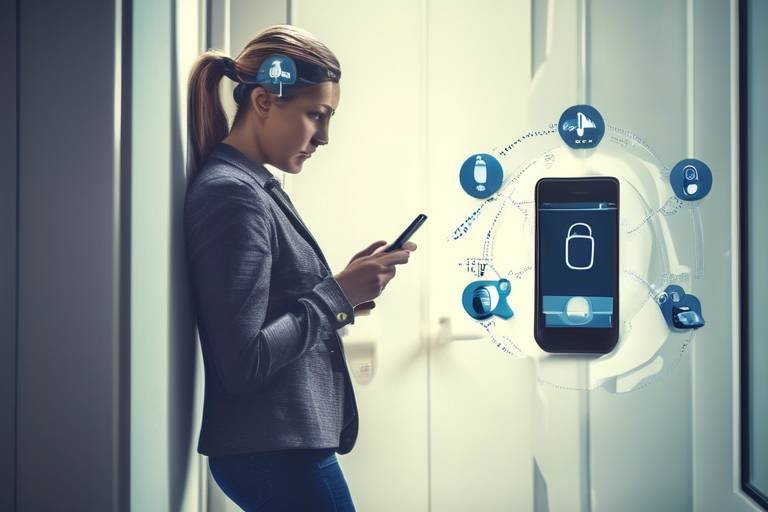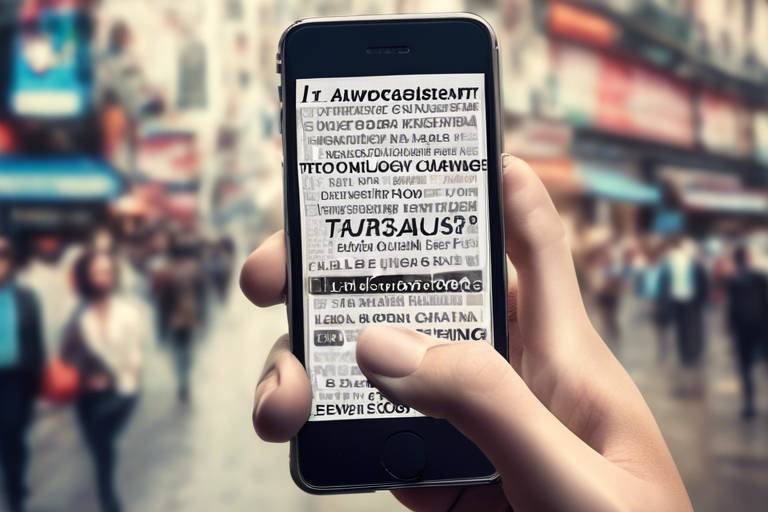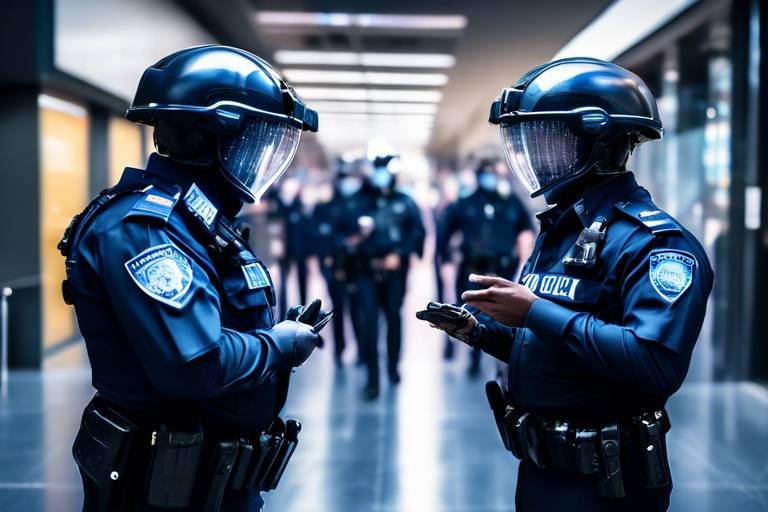How Smart Devices are Changing Personal Safety
In today's fast-paced world, the notion of personal safety has evolved dramatically, thanks in large part to the rise of smart devices. These innovative technologies are not just gadgets; they are powerful tools that are reshaping the way we think about security in our daily lives. Imagine being able to monitor your home while you're miles away, or receiving instant alerts if something seems amiss. Sounds like something out of a sci-fi movie, right? But it's happening right now, and it's revolutionizing how we protect ourselves and our loved ones.
The integration of smart technology into our homes and personal devices has made it easier than ever to stay aware of our surroundings. With features like real-time surveillance, emergency response connections, and remote access control, these devices offer a level of safety that was previously unimaginable. For instance, smart doorbells equipped with cameras allow homeowners to see who's at their door without opening it, effectively deterring potential intruders. This level of vigilance is like having a security guard at your doorstep 24/7!
Moreover, smart devices are not just limited to home security. Wearable technology, such as smartwatches, now includes safety features like location tracking and emergency alerts. Imagine going for a jog in a new neighborhood and having the peace of mind that, should anything happen, your watch can alert emergency services with your exact location. This is not just convenience; it's a game-changer in personal safety.
However, as we embrace these advancements, it's crucial to consider the implications for privacy and data security. Smart devices collect vast amounts of personal information to function effectively, which raises questions about who has access to this data and how it is used. Understanding these risks is essential for users, as it allows them to take proactive measures in safeguarding their information.
In this article, we will delve deeper into the various ways smart devices are enhancing personal safety, explore the integration of emergency services, and discuss the critical need for data privacy. We will also provide insights into the best practices for using these technologies responsibly. So, buckle up as we navigate this fascinating intersection of technology and personal safety!
Smart devices such as security cameras and doorbell systems provide real-time monitoring, allowing individuals to keep an eye on their surroundings and deter potential threats effectively. These devices have become a staple in many households, transforming how we view security at home. With high-definition video feeds and night vision capabilities, homeowners can monitor their properties from anywhere, ensuring peace of mind even when they are away. Imagine being able to check in on your home while on vacation or receiving a notification when someone approaches your front door. It’s like having a digital watchdog that never sleeps!
Many smart devices now feature direct connections to emergency services, enabling quicker responses in critical situations. This integration can significantly reduce the time it takes for help to arrive. For example, if a smart smoke detector senses a fire, it can automatically contact the fire department, ensuring that assistance is on the way before the homeowner even has a chance to react. This seamless connection can be the difference between a minor incident and a major disaster.
Innovative home security systems equipped with smart technology offer comprehensive protection, including alarms, motion detectors, and remote monitoring, ensuring safety even when homeowners are away. These systems can be customized to suit individual needs, providing tailored security solutions that fit every lifestyle. With the ability to monitor your home in real-time through a smartphone app, you can feel secure knowing that you're always in control.
Smart devices can send instant alerts to users' smartphones, keeping them informed about potential security breaches or emergencies, allowing for prompt action. This feature is incredibly beneficial for those who travel frequently or have busy lifestyles, as it ensures that they are always connected to their home security.
With smart locks and access systems, users can control entry to their homes from anywhere, enhancing security and convenience while allowing them to monitor who enters their property. No more worrying about whether you locked the door when you left; with a simple tap on your phone, you can check and lock it remotely.
Wearable technology, such as smartwatches and fitness trackers, can incorporate safety features like location tracking and emergency alerts, providing users with peace of mind during their daily activities. Whether you’re hiking in the woods or simply running errands, having a device that can alert someone if you’re in danger is invaluable.
As smart devices collect personal information to enhance safety, concerns about data privacy and security become paramount. Understanding these risks is essential for users to protect themselves. The more we rely on these technologies, the more we must be aware of how our data is being used and stored. Are companies taking the necessary steps to protect our information? Are we giving away more than we realize?
Implementing strong encryption and security protocols in smart devices is crucial to safeguarding users' data and maintaining trust in these technologies. Users must ensure that their devices are updated regularly and that they are utilizing strong, unique passwords to enhance their security.
Educating users about the potential risks and best practices for using smart devices can empower them to make informed decisions regarding their personal safety and privacy. Awareness is the first step toward protection, and by understanding how to navigate the digital landscape safely, users can enjoy the benefits of smart technology without compromising their security.
- What are smart devices? Smart devices are electronic gadgets that connect to the internet and can be controlled remotely, often enhancing safety and convenience.
- How do smart devices improve personal safety? They offer features such as real-time monitoring, emergency alerts, and remote access control, providing users with enhanced security.
- Are there privacy concerns with smart devices? Yes, smart devices can collect personal data, raising concerns about how that information is used and stored.
- What can I do to protect my data? Ensure strong passwords, keep devices updated, and be cautious about the information you share.

Enhanced Surveillance Capabilities
This article explores the transformative impact of smart devices on personal safety, highlighting advancements in technology, user experiences, and the implications for privacy and security in everyday life.
Smart devices have revolutionized the way we approach personal safety, particularly through enhanced surveillance capabilities. Imagine a world where you can monitor your home from anywhere in the world, all thanks to cutting-edge technology. Devices like security cameras and smart doorbell systems have become indispensable tools for homeowners and renters alike. They provide real-time monitoring, allowing individuals to keep an eye on their surroundings and deter potential threats effectively. With features like high-definition video, night vision, and motion detection, these devices transform your smartphone into a powerful security hub.
Consider this: when you’re on vacation, the last thing you want to worry about is the security of your home. Smart surveillance systems act like a digital watchdog, alerting you to any unusual activity. For instance, a doorbell camera can notify you if someone approaches your front door, even if you’re thousands of miles away. This level of vigilance not only helps prevent break-ins but also provides peace of mind.
Moreover, the integration of artificial intelligence in surveillance technology has taken things a step further. Many modern security cameras utilize facial recognition and can distinguish between familiar faces and strangers. This means that you can receive alerts only when an unknown person is detected, reducing unnecessary notifications and allowing you to focus on what truly matters. Additionally, some systems can even analyze behavior patterns, alerting you to suspicious activities that might go unnoticed by the human eye.
Here’s a breakdown of some key features that enhance surveillance capabilities:
- Real-Time Alerts: Instant notifications sent to your smartphone whenever movement is detected.
- Cloud Storage: Storing video footage in the cloud ensures that you never lose important evidence.
- Remote Access: Access your camera feeds from anywhere, anytime, through a dedicated app.
- Two-Way Audio: Communicate with visitors or potential intruders directly through your device.
As we embrace these technologies, it's essential to consider the implications for our everyday lives. Enhanced surveillance capabilities not only empower individuals to take control of their safety but also challenge us to think about the balance between security and privacy. Are we comfortable with the idea of being watched, even in our own homes? This question is crucial as we navigate the world of smart devices.
In conclusion, the advancements in surveillance technology brought by smart devices have made personal safety more accessible than ever before. With features designed to provide peace of mind, users can enjoy their lives without the constant fear of the unknown. The future of personal safety is here, and it’s smarter than ever.
Many smart devices now feature direct connections to emergency services, enabling quicker responses in critical situations. This integration can significantly reduce the time it takes for help to arrive.
Innovative home security systems equipped with smart technology offer comprehensive protection, including alarms, motion detectors, and remote monitoring, ensuring safety even when homeowners are away.
Smart devices can send instant alerts to users' smartphones, keeping them informed about potential security breaches or emergencies, allowing for prompt action.
With smart locks and access systems, users can control entry to their homes from anywhere, enhancing security and convenience while allowing them to monitor who enters their property.
Wearable technology, such as smartwatches and fitness trackers, can incorporate safety features like location tracking and emergency alerts, providing users with peace of mind during their daily activities.
As smart devices collect personal information to enhance safety, concerns about data privacy and security become paramount. Understanding these risks is essential for users to protect themselves.
Implementing strong encryption and security protocols in smart devices is crucial to safeguarding users' data and maintaining trust in these technologies.
Educating users about the potential risks and best practices for using smart devices can empower them to make informed decisions regarding their personal safety and privacy.
Q: How do smart surveillance cameras work?
A: Smart surveillance cameras use Wi-Fi to connect to your home network, allowing you to view live footage and receive alerts on your smartphone.
Q: Are smart devices secure?
A: While many smart devices have built-in security features, users should always implement strong passwords and keep their software updated to enhance security.
Q: Can I access my smart devices remotely?
A: Yes, most smart devices allow remote access through dedicated applications, enabling you to monitor and control them from anywhere.
Q: What should I do if I suspect a security breach?
A: If you suspect a security breach, immediately check your surveillance footage, change your passwords, and contact local authorities if necessary.

Emergency Response Integration
In today's fast-paced world, the integration of smart devices with emergency response systems has revolutionized the way we approach personal safety. Imagine a scenario where a simple alert from your smart home system can connect you directly to emergency services with just a few taps on your smartphone. This seamless integration not only enhances your safety but also provides a sense of security that was previously unimaginable. With smart devices, the response time during critical situations can be significantly reduced, making a tangible difference between safety and danger.
Many modern smart devices are equipped with features that allow them to communicate directly with emergency services. For instance, when a security alarm is triggered, the system can automatically notify local authorities, ensuring that help is on the way even before you have a chance to call for assistance yourself. This capability is particularly beneficial in emergencies where every second counts, such as fires or break-ins. The ability to send real-time alerts can be a game-changer, providing peace of mind to users and their families.
Furthermore, the integration of emergency response systems is not limited to just home security. Wearable technology, such as smartwatches, can also play a crucial role in personal safety. Many of these devices come equipped with emergency SOS features that allow users to alert emergency contacts or services with a simple button press. This is especially valuable for individuals who may find themselves in vulnerable situations, such as elderly users or those who frequently travel alone.
However, it's important to consider the implications of such technology. With the increased connectivity comes the responsibility of ensuring that these systems are secure and reliable. Users must be aware of how their data is being used and stored. To mitigate risks, manufacturers are implementing stronger security measures, including encryption and secure communication protocols, to protect users' information. This is critical in maintaining trust in these life-saving technologies.
In conclusion, the integration of smart devices with emergency response systems is a remarkable advancement in personal safety. As technology continues to evolve, we can expect even more innovative solutions that enhance our ability to respond to emergencies. Embracing these advancements not only empowers users but also fosters a safer community for everyone.
- How do smart devices connect to emergency services? Smart devices often use internet connectivity to send alerts directly to emergency service providers when triggered.
- Can I customize the emergency contacts for my smart devices? Yes, most smart devices allow users to customize emergency contacts and settings according to their preferences.
- What should I do if my smart device malfunctions during an emergency? Always have a backup plan, such as a traditional phone, to contact emergency services if your smart device fails.

Smart Home Security Systems
When it comes to ensuring the safety of our homes, have revolutionized the way we protect our personal spaces. These innovative systems are not just about having a camera or an alarm; they integrate a variety of technologies that work in harmony to provide comprehensive protection. Imagine being able to monitor your home in real-time from anywhere in the world, thanks to your smartphone. That's the power of smart home security!
At the core of these systems are devices like smart cameras, motion detectors, and smart alarms. Each component plays a crucial role in creating a secure environment. For instance, smart cameras can send you live video feeds, allowing you to see who is at your door or what’s happening in your backyard, all from the palm of your hand. This level of surveillance not only helps in monitoring but also acts as a significant deterrent against potential intruders.
Moreover, these systems often come with features that enable remote monitoring. With the help of mobile applications, users can receive instant notifications about any unusual activity around their homes. For example, if a motion detector is triggered, you’ll get an alert on your phone, allowing you to take immediate action. This proactive approach to security can be the difference between a minor scare and a major incident.
Another exciting aspect of smart home security systems is their ability to integrate with other smart devices. For instance, when a security breach is detected, not only can the alarm sound, but smart lights can also flash, and doors can be locked automatically. This interconnectedness creates a robust security network that enhances your home’s safety. It’s like having a personal security team that works around the clock, ensuring your peace of mind.
To illustrate how these systems work, consider the following table that outlines some common features of smart home security systems:
| Feature | Description |
|---|---|
| Real-time Monitoring | Access live video feeds from your cameras via smartphone apps. |
| Instant Alerts | Receive notifications for unusual activities detected by sensors. |
| Remote Access | Control your security devices from anywhere at any time. |
| Integration with Other Devices | Connect with smart lights, locks, and other devices for enhanced security. |
In addition, smart home security systems often come equipped with features that allow for customization. Homeowners can set specific zones to monitor, adjust sensitivity levels, and even create schedules for when their systems should be armed or disarmed. This level of personalization means that you can tailor your security setup to fit your lifestyle, ensuring that you’re not only protected but also comfortable in your own home.
As we embrace these technological advancements, it's essential to remember that while smart home security systems offer numerous benefits, they also require a commitment to maintaining their security. Regular software updates and strong passwords are crucial in keeping these systems safe from cyber threats. After all, what's the point of having a smart system if it's vulnerable to hacking?
In conclusion, smart home security systems are not just a luxury; they are becoming a necessity in our ever-evolving world. With their enhanced surveillance capabilities, integration with other smart devices, and customizable features, they provide a level of security that traditional systems simply can't match. So, if you're looking to bolster your home’s safety, investing in a smart home security system might just be the smartest move you make!
- What are the main components of a smart home security system?
The main components typically include smart cameras, motion detectors, smart alarms, and a central hub that connects all devices.
- Can I monitor my home security system remotely?
Yes, most smart home security systems allow you to monitor your home via a smartphone app from anywhere in the world.
- How secure are smart home security systems?
While they provide enhanced security features, it's important to keep your devices updated and use strong passwords to protect against cyber threats.
- Do I need a professional installation?
Many smart home security systems are designed for easy DIY installation, but professional installation is also available if you prefer.

Mobile Alerts and Notifications
In today's fast-paced world, staying informed is more critical than ever, and from smart devices have become a game-changer in personal safety. Imagine receiving a notification on your smartphone that alerts you to unusual activity at your home while you're out enjoying a night with friends. This instant communication not only keeps you informed but also empowers you to take swift action. With features like real-time alerts, users can respond to potential threats before they escalate, making them feel more secure in their daily lives.
These notifications can come from various smart devices, such as security cameras, smart doorbells, or even home alarm systems. Each device is designed to send alerts directly to your mobile device, ensuring that you are always in the loop, no matter where you are. For instance, if a motion sensor detects movement in your backyard, you will receive an immediate alert, allowing you to check the live feed from your security camera. This level of connectivity not only enhances your safety but also helps deter potential intruders, as they are aware that the homeowner is always vigilant.
Moreover, mobile alerts can be customized according to your preferences. You can choose to receive notifications for specific events, such as when someone rings your doorbell or when a door is opened. This flexibility ensures that you are not overwhelmed with unnecessary alerts, allowing you to focus on what truly matters. For example, you might prefer to receive alerts only when a person is detected, rather than every time a pet wanders by the camera. This tailored approach enhances user experience, making smart devices not just tools for safety but also for convenience.
Some systems even integrate with emergency services, meaning that if you receive an alert indicating a break-in, you can quickly contact the authorities with just a few taps on your phone. This integration is a huge leap forward in personal safety technology, as it drastically reduces the response time in critical situations. In essence, mobile alerts and notifications are not just about keeping you informed; they are about giving you the power to act decisively when it matters most.
However, while these features significantly enhance personal safety, it's essential to consider the implications of constant connectivity. Users should be aware of their privacy settings and ensure that their devices are secure from unauthorized access. Regularly updating your device's software and using strong passwords can help mitigate risks associated with mobile alerts. Ultimately, the balance between staying informed and protecting your privacy is crucial in the age of smart technology.

Remote Access Control
Imagine being able to unlock your front door without even being there. Sounds like something out of a sci-fi movie, right? Well, welcome to the world of ! This innovative technology is revolutionizing how we secure our homes and manage access to our personal spaces. With smart locks and access systems, you can control who enters your home from anywhere in the world, all from the convenience of your smartphone. It’s like having a virtual doorman at your fingertips!
Remote access control systems typically come equipped with features that allow you to grant or revoke access to your home with just a few taps on your phone. Whether you're at work, on vacation, or simply out running errands, you can monitor who is entering your property in real time. This not only enhances your security but also provides a level of convenience that traditional locks simply can’t match. Imagine the peace of mind you’ll have knowing that you can check the status of your door and lock it if you forgot to do so before leaving.
Furthermore, many of these smart locking systems integrate with your existing home automation setups. You can create unique access codes for family members, friends, or service providers, which can be easily modified or deleted as needed. For instance, if a neighbor is watering your plants while you’re away, you can give them temporary access without needing to hand over a physical key. This level of flexibility is a game changer in personal safety and convenience!
However, it’s essential to consider the security implications of remote access control. While these systems are designed with advanced encryption and security protocols, they are still susceptible to hacking if not properly managed. Always ensure that your devices are updated with the latest security patches and that you use strong, unique passwords. Additionally, enabling two-factor authentication can significantly enhance your security, providing an extra layer of protection against unauthorized access.
As we embrace this technology, it’s crucial to strike a balance between convenience and security. Smart locks can be incredibly beneficial, but they require users to be vigilant and informed about their usage. The more you understand how these systems work, the better equipped you’ll be to protect your home. After all, the goal is to enhance your safety while enjoying the conveniences that modern technology has to offer.
- What is remote access control? Remote access control allows you to manage and monitor access to your home remotely, typically via a smartphone app.
- How secure are smart locks? Smart locks use encryption and security protocols to protect against unauthorized access, but it’s vital to keep your devices updated and use strong passwords.
- Can I give temporary access to someone? Yes, most smart locks allow you to create temporary access codes for guests or service providers, which can be easily modified or revoked.
- Do I need an internet connection for remote access? Yes, most remote access systems require an internet connection to function properly.

Wearable Safety Devices
In today's fast-paced world, have emerged as a beacon of hope for those seeking peace of mind in their daily lives. Imagine strapping on a wristband or smartwatch that not only tracks your fitness but also keeps you safe. These devices are not just about counting steps; they play a crucial role in personal safety. With features like location tracking and emergency alerts, wearables provide an extra layer of protection that can be a game changer. For instance, if you find yourself in a precarious situation, many of these devices allow you to send an immediate alert to your contacts or emergency services with just a press of a button. This instant connection can be lifesaving.
Moreover, the integration of advanced technology in wearables means that they are becoming smarter every day. Some devices can detect falls or unusual movements, automatically alerting emergency contacts if you are unable to do so yourself. This feature is particularly beneficial for the elderly or those with medical conditions. Think of it as having a safety net that’s always with you, ready to act when you need it most.
Additionally, many wearable safety devices come equipped with health monitoring capabilities, such as heart rate tracking and sleep analysis. This data can be invaluable not only for personal health but also for safety, as it can alert users to potential health issues before they escalate. For example, if your heart rate spikes unexpectedly, your device can notify you and your emergency contacts, ensuring that you get the help you need.
However, while the benefits of wearable safety devices are clear, it's essential to consider the implications of using them. As these devices collect sensitive information, users must be aware of data privacy concerns. Ensuring that your device has strong encryption and security measures in place is crucial. Always check the privacy settings and understand how your data is being used. After all, your safety shouldn't come at the cost of your privacy.
In summary, wearable safety devices are revolutionizing personal safety by combining functionality with technology. They offer a unique blend of convenience and security, making them an essential tool in our daily lives. Whether you're a busy parent, an active senior, or someone who frequently travels, these devices can provide that extra layer of safety you might need. So, why not embrace the future of personal safety and explore the options available? Your peace of mind could be just a wristband away!
- What are wearable safety devices?
Wearable safety devices are gadgets like smartwatches and fitness trackers that include features for personal safety, such as location tracking and emergency alerts.
- How do wearable safety devices work?
These devices use GPS and Bluetooth technology to track your location and can send alerts to emergency contacts or services when needed.
- Are wearable safety devices secure?
While they offer many benefits, it’s important to choose devices with strong encryption and to understand their privacy policies to protect your personal information.
- Can wearable safety devices monitor health?
Yes, many wearables come with health monitoring features that track metrics like heart rate, sleep patterns, and physical activity, contributing to overall safety.

Data Privacy Concerns
As we embrace the convenience of smart devices, a shadow looms over the benefits they provide: . With each device we integrate into our lives, we inadvertently share a treasure trove of personal information. Think about it: from our daily routines to our locations, smart devices are constantly collecting data to enhance our experiences. However, this data collection raises significant questions: Who has access to this information? How is it being used? And most importantly, how secure is it?
In an era where cybersecurity threats are rampant, understanding the implications of data privacy is crucial. Smart devices can be vulnerable to hacking, which could lead to unauthorized access to sensitive information. Imagine someone being able to track your movements or access your home security system just because of a vulnerability in your smart lock. It’s a chilling thought, isn’t it?
Moreover, many users are unaware of the extent to which their data is being collected and shared. This lack of awareness can lead to a false sense of security. To illustrate this, consider the following common practices of smart devices:
- Data Collection: Smart devices often collect data on user behavior, preferences, and even health metrics.
- Third-Party Sharing: Some manufacturers may share this data with third parties for marketing or research purposes.
- Cloud Storage: Data is frequently stored in the cloud, which can be susceptible to breaches.
To combat these concerns, manufacturers are increasingly implementing encryption and security measures to protect user data. However, these measures are only as effective as the user's understanding of their importance. For example, users should be aware of the significance of regularly updating their devices, as these updates often patch security vulnerabilities.
Additionally, user education plays a vital role in safeguarding personal information. Many individuals do not realize that they can control their privacy settings on smart devices. By familiarizing themselves with these settings, users can limit the amount of data collected and shared. This is where a proactive approach comes into play; it's not just about owning smart devices but also about understanding how to use them safely.
In conclusion, while smart devices undoubtedly enhance our lives, they also come with a set of privacy challenges that cannot be ignored. By staying informed and vigilant, users can enjoy the benefits of technology while minimizing the risks associated with data privacy. The key is to strike a balance between convenience and security, ensuring that our personal information remains just that—personal.
Q: What types of data do smart devices collect?
A: Smart devices can collect a variety of data, including location information, usage patterns, health metrics, and personal preferences.
Q: How can I protect my data privacy with smart devices?
A: To protect your data privacy, regularly update your devices, adjust privacy settings, and be cautious about what information you share.
Q: Are all smart devices equally secure?
A: No, security can vary widely between devices. It's essential to research and choose reputable brands that prioritize user security.
Q: What should I do if I suspect my smart device has been compromised?
A: If you suspect a compromise, immediately disconnect the device from the internet, reset it to factory settings, and change any associated passwords.

Encryption and Security Measures
In the digital age, where personal safety is increasingly intertwined with technology, play a pivotal role in protecting users' data. Imagine your personal information as a treasure chest; encryption acts as a robust lock that only you can open. By encoding data, encryption ensures that even if a malicious actor gains access to your information, they won't be able to decipher it without the correct key. This is especially crucial for smart devices that continuously collect and transmit sensitive data, such as location and personal habits.
Moreover, it's not just about having a lock; it's about ensuring that the lock is of the highest quality. The implementation of advanced encryption protocols, such as AES (Advanced Encryption Standard) and SSL/TLS (Secure Sockets Layer/Transport Layer Security), is essential. These protocols create secure connections between devices and the internet, preventing unauthorized access and ensuring that data remains confidential. For instance, when you receive a mobile alert from your smart home security system, you want to be certain that the information being transmitted is shielded from prying eyes.
However, encryption alone isn't enough. It's crucial for manufacturers to continuously update their devices with the latest security patches to address vulnerabilities. Just like a castle needs regular maintenance to fend off invaders, smart devices require ongoing vigilance to keep them secure. Users should also take proactive steps, such as changing default passwords and enabling two-factor authentication whenever possible. This additional layer of security makes it significantly harder for hackers to breach your defenses.
To further illustrate the importance of these measures, consider the following table that highlights common encryption methods and their effectiveness:
| Encryption Method | Strength | Common Uses |
|---|---|---|
| AES | High | File encryption, VPNs |
| RSA | Medium | Secure data transmission |
| SSL/TLS | High | Secure web browsing |
| SHA (Secure Hash Algorithm) | Medium | Data integrity verification |
By understanding the various encryption methods and their applications, users can make informed decisions about the smart devices they choose to integrate into their lives. It's essential to remember that while technology can enhance personal safety, it also presents new challenges. Therefore, staying informed and vigilant about encryption and security measures is not just a precaution; it's a necessity in our increasingly connected world.

User Awareness and Education
In today's fast-paced digital world, the importance of cannot be overstated, especially when it comes to smart devices and personal safety. With the rapid advancement of technology, many individuals find themselves using devices that they may not fully understand. This lack of knowledge can lead to vulnerabilities and potential risks. Imagine walking into a bustling marketplace, where every stall is filled with unfamiliar products; without guidance, you might miss out on the best items or even get lost. Similarly, when it comes to smart devices, users must be equipped with the knowledge to navigate this complex landscape effectively.
One of the key aspects of user education is understanding how smart devices collect and utilize personal data. For instance, many users may not realize that their smart security cameras are constantly recording and storing footage. This means that if proper security measures aren’t taken, sensitive information could be exposed. Therefore, users should be educated on the importance of configuring privacy settings correctly. It’s like locking your front door; if you leave it open, anyone can walk in. Ensuring that your smart devices are set up with the right privacy measures is crucial for maintaining personal safety.
Moreover, education should extend to recognizing potential threats and understanding how to respond effectively. For example, users should know how to identify phishing attempts that may target their smart devices. Phishing is akin to a wolf in sheep's clothing; it may look harmless, but it can cause significant harm if not recognized. By educating users on how to spot such threats, we can empower them to take action before any damage is done.
Another essential element of user awareness involves keeping devices updated. Regular software updates are crucial as they often contain important security patches that protect against new vulnerabilities. Think of it as maintaining your car; regular check-ups can prevent breakdowns and ensure safety on the road. Users should be encouraged to enable automatic updates or regularly check for updates manually to keep their devices secure.
To facilitate this education, organizations and manufacturers can play a vital role. They can provide resources such as tutorials, webinars, and user guides that explain how to use devices safely and effectively. A well-informed user is a safer user. Additionally, community workshops can create a space for individuals to ask questions and share experiences, fostering a culture of safety and awareness.
In conclusion, user awareness and education are fundamental in navigating the world of smart devices. By understanding the risks and implementing best practices, users can significantly enhance their personal safety. As we continue to integrate technology into our daily lives, let’s ensure we are not just passive users but informed and proactive participants in our safety journey.
- What should I do if I suspect my smart device has been hacked?
If you suspect your device has been compromised, immediately disconnect it from the internet and reset it to factory settings. Change all associated passwords and consider contacting customer support for further assistance. - How can I ensure my smart devices are secure?
Always update your devices with the latest software, use strong, unique passwords, and be cautious about granting permissions to apps. - Are all smart devices vulnerable to hacking?
While many smart devices can be vulnerable, using strong security measures can significantly reduce the risk. Always research and choose reputable brands.
Frequently Asked Questions
- How do smart devices enhance personal safety?
Smart devices enhance personal safety by providing real-time monitoring, emergency response integration, and remote access control. For instance, security cameras can alert you to unusual activity, while smart locks allow you to control who enters your home, even when you're not there.
- What are the benefits of smart home security systems?
Smart home security systems offer comprehensive protection through alarms, motion detectors, and remote monitoring. These features ensure that even when you're away, you can keep an eye on your property and receive instant notifications about any security breaches.
- Can wearable devices improve my safety?
Absolutely! Wearable devices like smartwatches and fitness trackers can provide features such as location tracking and emergency alerts. This means that in case of an emergency, you can quickly notify someone or share your location with loved ones, giving you peace of mind during your daily activities.
- What should I know about data privacy with smart devices?
Data privacy is a significant concern with smart devices since they collect personal information to enhance safety. It's essential to understand the potential risks and ensure that devices have strong encryption and security measures in place to protect your data.
- How can I protect my data when using smart devices?
To protect your data, make sure to use devices that implement strong encryption and regularly update their software. Additionally, educate yourself about best practices for using these devices, such as changing default passwords and being cautious about the information you share.
- Are smart devices easy to use for emergency situations?
Yes, many smart devices are designed to be user-friendly and can quickly connect you to emergency services. Features like mobile alerts and notifications ensure that you are informed immediately, allowing for prompt action when needed.



















